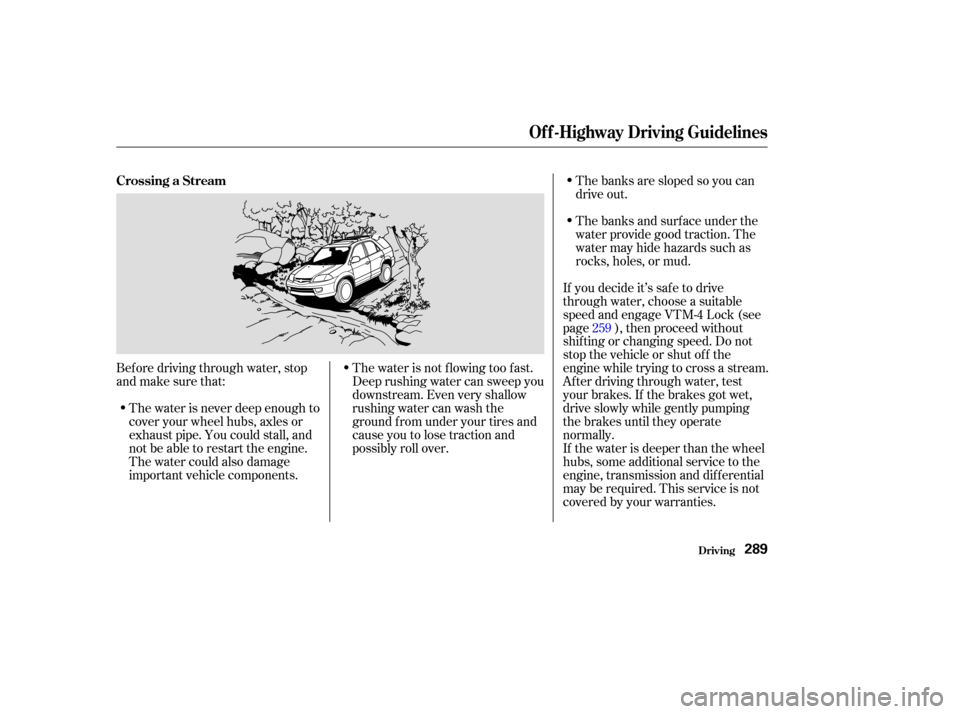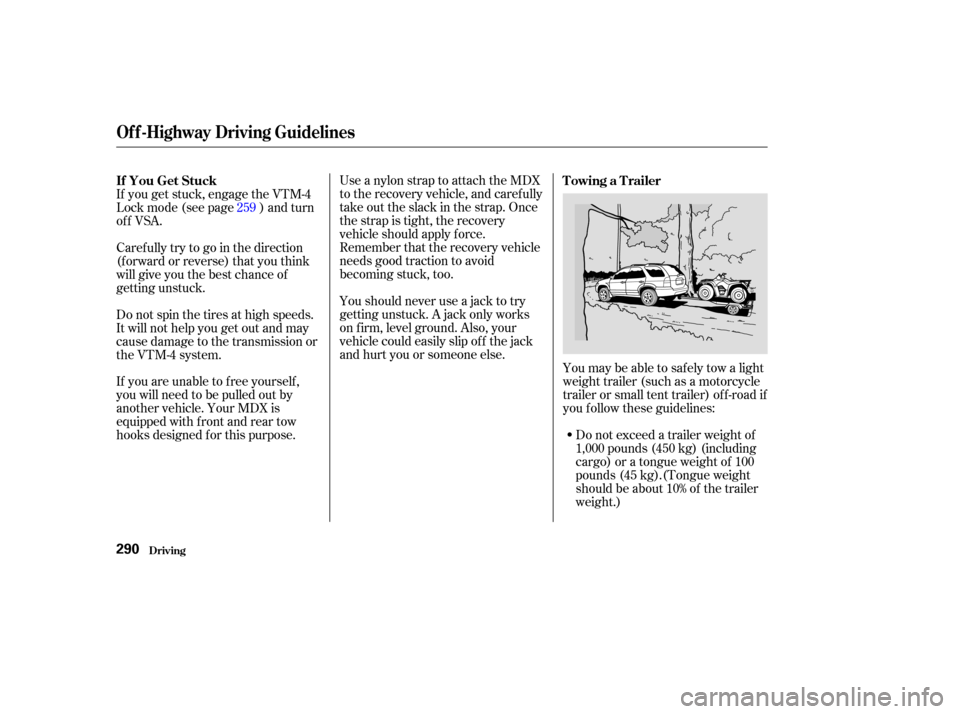Acura MDX 2003 Owner's Manua
Manufacturer: ACURA, Model Year: 2003, Model line: MDX, Model: Acura MDX 2003Pages: 420, PDF Size: 5.46 MB
Page 291 of 420

The f ollowing pages contain practical
tips on basic of f -highway operation.
Driving of f -highway can be hard on a
vehicle. Bef ore you leave the
pavement, be sure all scheduled
maintenance and service has been
done, and that you have inspected
your vehicle. Pay special attention to
the condition of the tires, and use a
gauge to check the tire pressures.Of f -highway, the general rule is to
keep your speed low. Of course,
you’ll need enough speed to keep
moving forward. But at higher
speeds, you have less time to assess
conditions and make good decisions.
There’s also a greater chance of
sliding if you brake or turn too
quickly on wet soil, gravel, or ice. In
any situation, never go f aster than
conditions allow.Generally, the best of f -pavement
braking technique is to gently
depress the brake pedal, then
increase pressure as more braking is
needed. Avoid hard braking. Keep in
mind that you will usually need more
time and distance to brake to a stop
on unpaved surf aces.
After you return to the pavement,
caref ully inspect your vehicle to
make sure there is no damage that
could make driving it unsaf e. Check
the tires for damage and for proper
pressure. If you need to brake hard because of
an emergency, apply steady, even
pressure to the brake pedal. Do not
pump the brakes; let the anti-lock
braking system pump them f or you.
If you pump the brakes, the anti-lock
cannot work as ef f iciently, and your
stopping distance may be increased.
Forbettertractiononallsurfaces,
accelerate slowly and gradually build
up speed. If you try to start too fast
on wet soil, mud, snow, or ice, you
might not have enough traction to
get underway. You may even dig
yourself into a hole. Starting with the
shif t lever in second gear (2) will
help get you to a smooth start on
snow and ice.
Togetbettertractionwhendriving
in deep sand, turn of f the VSA.
CONT INUED
Cont rolling Speed
Check Out Your Vehicle
A ccelerat ing and BrakingDriving T ips
Off-Highway Guidelines
Driving287
Page 292 of 420

Test your brakes from time to time
to make sure they are operating
properly. This will also give you a
f eel f or how much traction you have
on a given surf ace.
Off-highway, the basic turning
technique is to drive at low speed
and gradually adjust the amount of
steering to suit the surf ace.
You should have no problem making
sharp turns at low speed on level
ground. But never make an abrupt
turn at higher speeds, on or of f
pavement. With a higher center of
gravity, your vehicle can more easily
tip or roll over.Bef ore driving up or down a hill, stop
and assess the situation. If you can’t
clearly see all road conditions (good
traction, no bumps, holes or other
obstacles, a safe way out, etc.) walk
the slope bef ore you drive on it. If
you have any doubt about whether
you can saf ely drive on the slope,
. Find another route.
If you are driving up a hill and f ind
that you cannot continue (because of
the steepness, a large obstacle, etc.), . Your vehicle
could roll over. Slowly back down the
hill, f ollowing the same route you
took up the hill. Bumps, holes, rocks, and other
obstacles can be hazardous. Debris
in the road can damage your
suspension or other components.
Even small rocks can cut your tires.
More important, because your
vehicle has a high center of gravity,
driving over a large obstacle, or
allowing a wheel to drop into a deep
hole, can cause your vehicle to tip or
roll over.
Drive slow enough to observe
obstacles ahead and maneuver
around them. If you can’t avoid a
serious obstacle, turn around and
look f or a better route.
don’t do it
do not try to turn around
T urning
Avoiding Obstacles
Driving on Slopes
Off-Highway Guidelines
Driving288
Page 293 of 420

Bef ore driving through water, stop
and make sure that:The water is never deep enough to
cover your wheel hubs, axles or
exhaust pipe. You could stall, and
not be able to restart the engine.
The water could also damage
important vehicle components. The water is not f lowing too f ast.
Deep rushing water can sweep you
downstream. Even very shallow
rushingwatercanwashthe
ground f rom under your tires and
cause you to lose traction and
possibly roll over.The banks are sloped so you can
drive out.
The banks and surf ace under the
water provide good traction. The
water may hide hazards such as
rocks, holes, or mud.
If you decide it’s saf e to drive
through water, choose a suitable
speed and engage VTM-4 Lock (see
page ), then proceed without
shif ting or changing speed. Do not
stop the vehicle or shut of f the
engine while trying to cross a stream.
After driving through water, test
your brakes. If the brakes got wet,
drive slowly while gently pumping
the brakes until they operate
normally.
If the water is deeper than the wheel
hubs, some additional service to the
engine, transmission and dif f erential
mayberequired.Thisserviceisnot
covered by your warranties. 259
Crossing a Stream
Of f -Highway Driving Guidelines
Driving289
Page 294 of 420

Use a nylon strap to attach the MDX
to the recovery vehicle, and caref ully
take out the slack in the strap. Once
the strap is tight, the recovery
vehicle should apply f orce.
Remember that the recovery vehicle
needs good traction to avoid
becoming stuck, too.
You should never use a jack to try
getting unstuck. A jack only works
on f irm, level ground. Also, your
vehicle could easily slip of f the jack
and hurt you or someone else.You may be able to saf ely tow a light
weight trailer (such as a motorcycle
trailer or small tent trailer) of f -road if
you f ollow these guidelines:
Do not exceed a trailer weight of
1,000 pounds (450 kg) (including
cargo) or a tongue weight of 100
pounds (45 kg).(Tongue weight
should be about 10% of the trailer
weight.)
If you are unable to f ree yourself ,
you will need to be pulled out by
another vehicle. Your MDX is
equipped with f ront and rear tow
hooks designed f or this purpose. Donotspinthetiresathighspeeds.
It will not help you get out and may
cause damage to the transmission or
the VTM-4 system. If you get stuck, engage the VTM-4
Lock mode (see page ) and turn
of f VSA.
Caref ully try to go in the direction
(f orward or reverse) that you think
will give you the best chance of
getting unstuck.
259
If You Get Stuck
T owing a T railer
Of f -Highway Driving Guidelines
Driving290
Page 295 of 420

Trytostayonsmooth,leveldirt
roads, and avoid driving in hilly
terrain.
Allow extra room f or starting,
stopping, and turning.
Slow down if you encounter bumps
or other obstacles.
Of f -Highway Driving Guidelines
Driving291
Page 296 of 420

292
Page 297 of 420

This section explains the importance
of keeping your vehicle well
maintained and why you should
f ollow basic maintenance saf ety
precautions.
This section also includes
Maintenance Schedules f or normal
driving and severe driving conditions,
a Maintenance Record, and instruc-
tions f or simple maintenance tasks
you may want to take care of
yourself .......................
Maintenance Saf ety .294
.
Important Safety Precautions . 295
.................
Maintenance Schedule . 296
...
Required Maintenance Record . 303
.......
Owner Maintenance Checks . 305
..............................
Fluid Locations .306
......................................
Engine Oil .307
..................................
Adding Oil .307
....................
Recommended Oil .307
..............................
Synthetic Oil .308
....................................
Additives .308
.....
Changing the Oil and Filter . 309
.............................
Cooling System .311
............
Adding Engine Coolant . 311
.......
Replacing Engine Coolant . 313
....................
Windshield Washers .316
....
Automatic Transmission Fluid . 317
..........................
Dif f erential Fluid .318
.............
Transf er Assembly Fluid . 318
....................................
Brake Fluid .319
............................
Brake System .319
..............................
Power Steering .320
.....................
Air Cleaner Element .321
....................................
Hood Latch .323
....................................
Spark Plugs .323
..............................
Replacement .323 ............................
Specif ications .325
...........................................
Battery .326
.................................
Wiper Blades .328
..............
Air Conditioning System . 330
..................
Dust and Pollen Filter . 331
.....................................
Drive Belts .331
....................................
Timing Belt .332
...............................................
Tires .332
......................................
Inf lation .332
..................................
Inspection .334
..............................
Maintenance .335
.............................
Tire Rotation .335
...
Replacing Tires and Wheels . 336
......................
Wheels and Tires .337
..........................
Winter Driving .337
.............................
Snow Tires .338
............................
Tire Chains .338
.............................................
Lights .339
.....................
Headlight Aiming .341
........................
Replacing Bulbs .341
....................
Storing Your Vehicle .349
If you have the skills and tools to per-
f orm more complex maintenance
tasks on your Acura, you may want
to purchase the Service Manual. See
page f or inf ormation on how to
obtain a copy, or see your Acura
dealer.
405
Maintenance
Maint enance293
Page 298 of 420

Regularly maintaining your vehicle is
the best way to protect your
investment. Proper maintenance is
essential to your saf ety and the
saf ety of your passengers. It will also
reward you with more economical,
trouble-f ree driving, and help reduce
air pollution.Some of the most important saf ety
precautions are given here. However,
we cannot warn you of every
conceivable hazard that can arise in
perf orming maintenance. Only you
can decide whether or not you
should perf orm a given task.
This section includes instructions f or
simple maintenance tasks, such as
checking and adding oil. Any service
items not detailed in this section
should be perf ormed by an Acura
technician or other qualif ied
mechanic.
Maintenance Saf ety
Maint enance294
Failure to properly follow
maintenance instructions and
precautions can cause you to
be seriously hurt or killed.
Always follow the procedures
and precautions in this owner’s
manual.
Improperly maintaining this
vehicle or failing to correct a
problem before driving can
cause a crash in which you can
be seriously hurt or killed.
Always follow the inspection
and maintenance
recommendations and
schedules in this owner’s
manual.
Page 299 of 420

Bef ore you begin any maintenance,
make sure your vehicle is parked on
level ground and that the parking
brake is set. Also, be sure the engine
is of f . This will help to eliminate
several potential hazards:Be sure
there is adequate ventilation
whenever you operate the engine.
Let the
engine and exhaust system cool
bef ore touching any parts. Read the instructions before you
begin, and make sure you have the
tools and skills required.
To reduce the possibility of f ire or
explosion, be caref ul when working
around gasoline or batteries. Use a
commercially available degreaser or
parts cleaner, not gasoline, to clean
parts. Keep cigarettes, sparks, and
flames away from the battery and all
f uel-related parts.
Do
not run the engine unless in-
structed to do so. You should wear eye protection and
protective clothing when working
near the battery or when using
compressed air.
Maintenance Saf ety
Maint enance
Important Saf ety Precautions
Carbon monoxide poisoning
f rom engine exhaust.
Burns f rom hot parts.
Injury f rom moving parts.
295
Page 300 of 420

The Maintenance Schedule specif ies
how of ten you should have your
vehicle serviced and what things
need attention. It is essential that
you have your vehicle serviced as
scheduled to retain its high level of
saf ety, dependability, and emissions
control perf ormance.Service your vehicle according to the
time and mileage periods on one of
the Maintenance Schedules on the
f ollowing pages. Select the schedule
f or ‘‘Severe Conditions’’ if most of
your driving is done under one or
more of the conditions listed on that
page. Otherwise, f ollow the schedule
f or ‘‘Normal Conditions.’’
The services and time or distance
intervals shown in the maintenance
schedule assume you will use your
vehicle as normal transportation f or
passengers and their possessions.
You should also f ollow these
recommendations:
Avoid exceeding your vehicle’s
load limit. This puts excess stress
on the engine, brakes, and many
other parts of your vehicle. The
load limit is shown on the tire
inf ormation label on the driver’s
doorjamb. Operate your vehicle on
reasonable roads within the legal
speed limit.
Drive your vehicle regularly over a
distance of several miles
(kilometers).
Always use unleaded gasoline with
theproperoctanerating(seepage
).
236
Maintenance Schedule
Maint enance
Which Schedule to Follow:
296